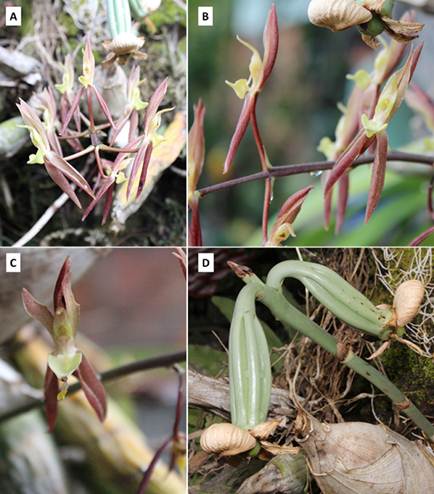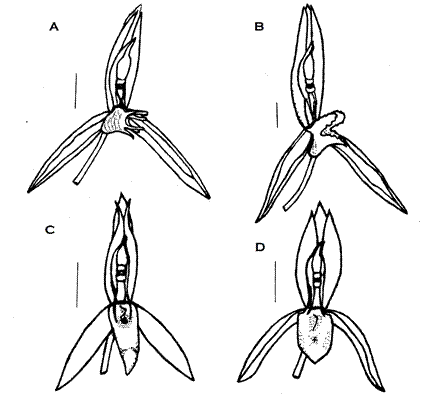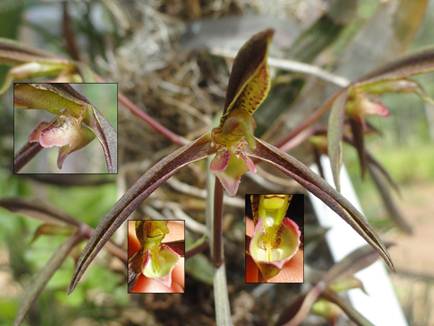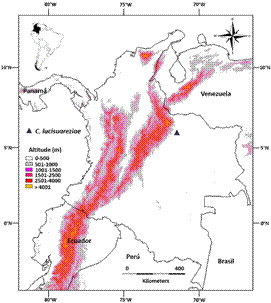Introduction
Orchidaceae include about 28,000 species and, together with Asteraceae, it is the most diverse group of angiosperms (Chase et al. 2015). Colombia is one of the countries with the greatest diversity of Orchidaceae, with 4,270 species in 270 genera; about 35% of the species are endemic (Betancourt, Sarmiento, Toro-González & Valencia 2015). Most of the endemic species are native to the Andean bioregion. The areas with the lowest diversity are the Orinoco river basin and the Atlantic slopes, with only 143 species recorded (Betancourt et al. 2015, Sarmiento 2007).
The genus Catasetum includes about 140 species distributed throughout the Neotropics (Romero & Jenny 1993, Romero 2012), although Chase et al. (2015) accept up to 176 taxa. For Colombia, Ortiz and Uribe (2007, 2014), Bonilla, Mosquera and Otero (2013a), Ortiz (2015) and Betancourt et al. (2015) recognize 37 species.
Materials and methods
Casanare is one of the least studied departments of Colombia (Usma & Trujillo 2011). In the Orchidaceae, 32 genera and 58 species have been recorded from this area (Betancourt et al. 2015). However, recent studies conducted in the Orinoco river basin addressed the importance of the region’s biodiversity, showing that 77 orchid species were recorded in the Meta Department alone (Jiménez 2011). Two years after the start of the explorations in this region, the number of documented orchid species already overcome the 300 taxa (Bonilla et al. 2013b).
The material examined for this study was collected in 2013, during the exploration of Casanare, when a population of a unidentfied species of Catasetum was found in the town of Hato Corozal. The plants were cultivated in a greenhouse at Villavicencio (Meta), in the farm of Luci Suárez, for their documentation and study.
Results
Based on floral morphology, the new species described hereafter, Catasetum lucisuareziae, belongs to a small group of species that in Colombia includes C. bicolor Klotzsch, C. callosum Lindl. and C. rectangulare G.F.Carr.
Key To The Colombian Species Of Catasetum Related To C. Lucisuareziae
1. Petals linear to oblong-lanceolate ………………………………2
2. Lateral sepals falcate, labellum rectangular……...C. rectangulare
2’. Lateral sepals reflexed or oblique, labellum lanceolate, ovate or trilobed…………………………………………………………….3
3. Labellum lanceolate, ovate or slightly off site with a central callus apiculate ……………………………………………….C. callosum
3’. Labellum trilobed, without a callus ……………………...C. boyi
1’. Petals elliptic or elliptic-lanceolate……………………………..4
4. Labellum trilobed, the mid-lobe slightly elliptic ………C. lucisuareziae
4’. Labellum pentalobed, the mid-lobe triangular ………C. bicolor
Catasetum lucisuareziae M. Bonilla, J. Mosquera & Benelli, sp.nov. Fig. 1-2.
TYPE: Colombia. Casanare: Hato Corozal, Bosque de Sabana, 6.133541° -71.728464°, 222 m, 26-VI-2013, M Bonilla-M., J Mosquera, A Velázquez & L Suárez, s.n. (holotype, LLANOS!).
Diagnosis
Catasetum lucisuareziae is similar to C. bicolor, from which it mainly differs by the 3-lobed labellum (vs. 5-lobed) and the two subglobular calli at the base of the lip (vs. two ligules); it also resembles C. rectangulare and C. callosum, from which it differs by the ovate-lanceolate bracts, elliptic petals, 3-lobed labellum with 2 basal subglobular calli, and erect staminal column.
Epiphytic, cespitose herb, 15-40 cm tall when leafy. Pseudobulb ca. 13 × 6 cm, terete, ellipticalspindle, of 1-9 internodes. Leaves ca. 25 × 4 cm, oblong-lanceolate, distichous, plicate, deciduous. Inflorescence basal, 1-2 symultaneous, manyflowered (12-20) racemes, straight or curved at the apex, ca. 25 cm long, provided with basal bracts. Male flowers resupinate, fragrant, brown, the labellum yellow-green. Pedicel ca. 45 mm long, including the short ovary. Floral bracts lanceolateovate, 9 × 3 mm. Dorsal sepal oblong-elliptic, acute, concave, membranous, ca. 29 × 7 mm. Lateral sepals elliptic, acute, convex, membranous, ca. 30 × 7 mm. Petals elliptic, convex, membranous, ca. 26 × 5 mm. Labellum 3-lobed, sacciform, cordate when spread, fleshy, 6-7 mm long, 10.0-10.8 mm wide, 9 mm deep, the lateral lobes elliptic with the margin sometimes undulate, the midlobe triangular, round, with two subglobular calli at the base. Column trigonous, erect, ca. 18 mm long, 3-4 mm wide toward the apex, yellowish-green stained brown; rostellum 6-8 mm, slim and projected forward and backward. Anther operculate, apiculate, unilocular, ca. 9 × 3 mm, the apex yellowish-green. Pollinia 2, elliptic-obovate, flattened dorsiventrally, split, yellow, ca. 3 × 1 mm, on a oblong stipe and sticky viscidium. Female flowers not observed. Immature fruit green, trilocular.
Distribution
The species has been hiterto recorded only from the municipality of Hato Corozal (Fig. 3).
Eponymy
In honor of Luci Suárez, who has taken charge of the conservation and management of native orchid species of Meta.
Conservation Status
According to the criteria of the IUCN (2014), C. lucisuareziae is characterized as Data Deficient (DD). The only known population of the species is not located within any conservation unit. However, ex situ conservation management performed by Mrs. Luci Suárez and his son on their farm is highly relevant for its preservation.
Catasetum lucisuareziae belongs to subgenus Catasetum section Isoceras (Mansf.) Senghas, characterized by symmetrical antennae (Senghas 1990, Romero 2009).
Among the species found in the bioregion of the Orinoco (Bonilla et al. 2014), the most alike are C. rectangulare and C. callosum. The three species can be easily distinct, however, on the basis of their characteristic floral morphology (Table 1). Catasetum rectangulare and C. callosum have linear and oblong-lanceolate floral bracts, respectively, while C. lucisuareziae has ovate-lanceolate bracts. While in C. lucisuareziae the petals are elliptic, they are linear to oblong-lanceolate in C. rectangulare and C. callosum.

Figure 1 Catasetum lucisuareziae. A. Male flower, frontal view. B. Column set: a, frontal view; b, lateral view. C. Column with labellum set: a, lateral view; b, same, with the labellum longitudinally sectioned. D. General view of the plant habit without leaves, the inflorescence with male flowers. E. Male flower, dissected perianth: a, dorsal sepal; b, petal; c, lateral sepal; d, labellum, frontal view. F. Pollinarium, two views. G. Anther cap in frontal, lateral and dorsal views. H. Floral bract. Illustration by M. M. Bonilla-M. from the type.

Figure 2 Catasetum lucisuareziae M. Bonilla, J. Mosquera & Benelli. A. Inflorescence. B. Male flower, lateral view. C. Male flower, frontal view. D. Imature fruit. Illustration by M. M. Bonilla-M.
Table 1 Comparison of floral details between Catasetum lucisuareziae and its closest relatives.
| - | Catasetum lucisuareziae | C. rectangulare | C. callosum | C. boyi |
|---|---|---|---|---|
| Bract | Oval-lanceolate | Lanceolate | Oblong | Ovate-lanceolate |
| Peduncle | 30 ×4-5 mm | 25-30 × 3.5-4 mm | 25-30 × 3.5-4 mm | 40 × 2-3 mm |
| Dorsal sepal | 29 × 7 mm | 25-31 × 5-6 mm | 25-42 × 6-8 mm | 25 × 8 mm |
| Lateral sepal | 30 × 7 mm, reflexed | 23-27 × 5-7 mm, falcate | 24-4 × 8-9 mm, reflexed somewhat oblique | 38 × 4 mm, reflexed |
| Petals | 26 × 5 mm, elliptic | 22-25 × 5-7 mm, linear to oblong-lanceolate | 22-38 × 5-55 mm, linear to oblong-lanceolate | 25 × 8 mm |
| Labellum | 6 mm long × 10 mm wide × 9 mm deep | 17 mm long × 6 mm wide × 4 mm deep | 13-21 mm long × 8-10 mm wide × 5-6 mm deep | 6 mm long × ca 4 mm wide × ca 3 mm deep |
| Labellum ornament | Trilobed, lateral lobes with denticulate margin, slightly elliptical margin entire central lobe and two subglobular calluses, smooth, basal | Entire, rectangular, margin entire or denticulate, triangular apex, callus I dispersed in the base with a central uplift. | Entire, lanceolate, ovate or slightly pandurate, smooth or irregularly toothed margin, acute apex, central callus and a lifting apiculate | Trilobed, lateral lobes with filiform margin, semiovate margin filiform central lobe and two erect triangular calluses, basal |
| Staminate Column | Erect, 18 × 3-4 mm | Arched, 14 × 7 mm | Slightly curved, 12 × 5-6 mm | Erect, 20 × 4 mm |

Figure 4 Comparison of the flowers between A. Catasetum bicolor, B. C. boyi, C. C. callosum and D. C. retangulare. Illustration by M. M. Bonilla-M. and A. Petini-Benelli.

Figure 5 Catasetum boyi, frontal and lateral view, with closeups of the labellum. Photography by A. Petini-Benelli.
In addition, C. lucisuareziae has a lobed labellum with two subglobulares calli (vs. entire with a single callus), and the apex straight basck (vs. arched and slightly curved) (Table 1).
Catasetum lucisuareziae can also be compared to C. bicolor, which is recorded for Colombia in the bioregion of the Atlantic and the Middle Magdalena valley between the Cordillera Central (CC) and the Cordillera Oriental (CO), on the western flank. However, it was not registered from the eastern flank of the CO or the bioregion of the Orinoco (Bonilla et al. 2013b, Ortiz 2015). Nevertheless, the 3-lobed labellum with elliptical lobes distinguishes this species, whereas in C. bicolor the lip is 5-lobed with three lobes at the apex (the triangular central lobe triangular and the other two linear), and the laterals lobes are upright. Moreover, instead of the two subglobular calli at the base of the lip, C. bicolor presents two ligules, one on each side lobe. The new species and C. bicolor can also be compared to C. boyi Mansf. However, while C. bicolor is distributed from Panama to Venezuela, C. boyi is exclusively known from Brazil (Govaerts et al. 2015), in regions quite distant from the area of occurrence of C. lucisuareziae in the Colombian Orinoquia. The main morphologic differences between the species of this complex can be by observed in Figure 4, where the flowers of the four species related to C. lucisuareziae are shown. Catasetum lucisuareziae differs from C. boyi by its elliptic oblong, 2.9 cm long dorsal sepal versus elliptic-lanceolate, 2.5 cm long. The lateral lobes of the labellum are suberect in C. lucisuareziae, vs. distinctly erect in C. boyi (Fig. 5); in the first species they have slightly undulate margins and the mid-lobe is smooth, whilst in the latter the margins of the lateral lobes and the midlobe are strongly undulate; in the central portion, the labellum of C. lucisuareziae is 9 mm depth, while in C. boyi it is only 3 mm depth; the calli of the lip are subglobular in C. lucisuareziae, but they are triangular and obliquely erect in C. boyi.












 uBio
uBio 


